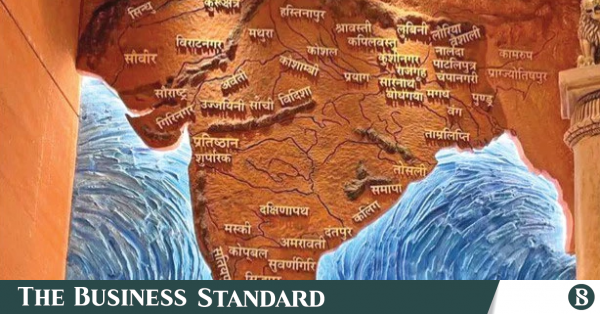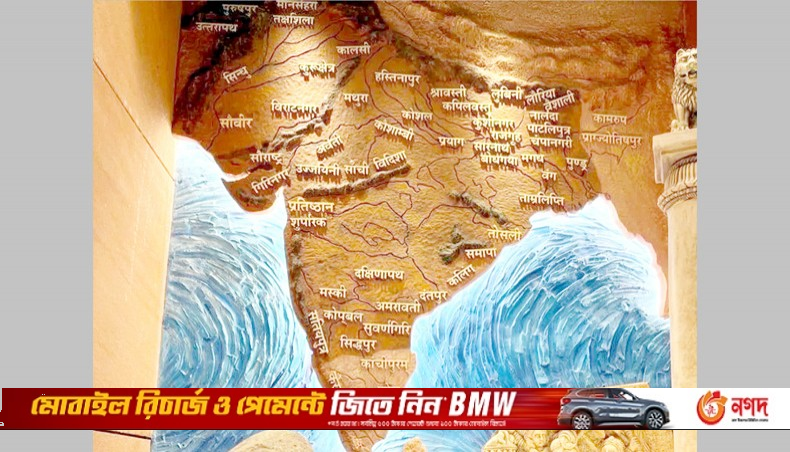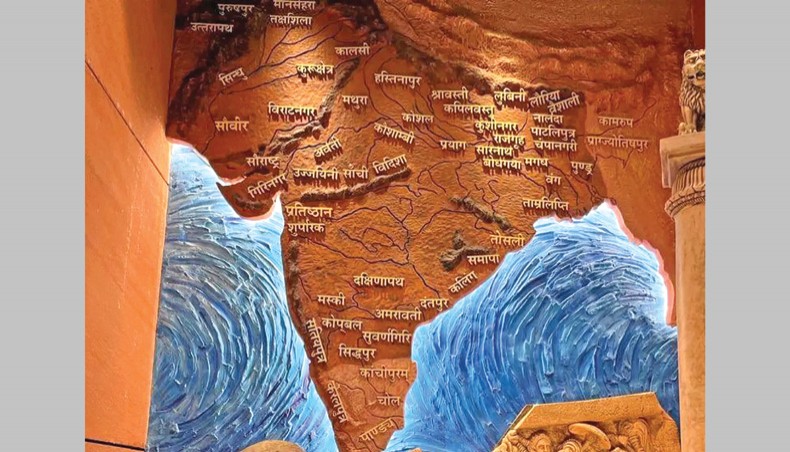Oppositions, freedom fighters decry India’s ‘Akhand Bharat’ mural
Ahammad Foyez | Published: 23:26, Jun 03,2023
Opposition parties and decorated freedom fighters have reacted sharply to the ‘Akhand Bharat’ map of the Indian subcontinent depicted in a mural on the newly inaugurated parliament building...

www.newagebd.net
Photo shows ‘Akhand Bharat’ mural placed in new parliament building of India that triggers huge criticisms in Neighbouring countries. — Photo courtesy News9
Opposition parties and decorated freedom fighters have reacted sharply to the ‘Akhand Bharat’ map of the Indian subcontinent depicted in a mural on the newly inaugurated parliament building of India.
On May 28, Indian prime minister Narendra Modi inaugurated the mural with the concept of Akhand Bharat, meaning ‘Undivided India,’ which refers to the idea of a undivided Indian subcontinent, encompassing present-day India, Bangladesh, Pakistan, Afghanistan, Nepal, Sri Lanka, and Myanmar.
The Pakistani government and Nepalese politicians separately expressed their grievances over the idea of ‘Undivided India’ incorporating their countries into the scheme.
The government of Bangladesh has yet to come out with any reaction, while the ruling Awami League’s international affairs secretary has refused to comment on the issue.
Talking to New Age on Saturday, freedom fighters and politicians said that such an action by India was a threat to sovereignty and would create controversy in regional politics.
When approached, AL international affairs secretary Shammi Ahmed denied making any comment.
Bangladesh’s foreign ministry also did not make a statement on the issue until Saturday evening, while the foreign minister, the state minister for foreign affairs, and the foreign secretary could not be reached for comments.
State minister Md Shahriar Alam even did not respond to the text message seeking the government’s reaction on the matter.
In 2015, Indian right-wing organisation Rashtriya Swayamsevak Sangh leader Ram Madhav, when asked about a map that showed Pakistan and Bangladesh as part of India, told Al Jazeera, ‘The RSS still believes that one day these parts, which have historical reasons separated only 60 years ago, will again, through popular goodwill, come together and Akhand Bharat will be created.’
India’s ruling party, the Bharatiya Janata Party, is one of several organisations through which the RSS promotes the idea of a Hindu nation.
The main opposition Bangladesh Nationalist Party secretary general, Mirza Fakhrul Islam Alamgir, said that it was a serious intervention in the independence of Bangladesh.
‘This is a shameful move by India for Bangladesh and other neighbouring countries. Bangladesh government should have protested the incident immediately,’ Fakhrul said.
Decorated freedom fighter and Krishak Sramik Janata League president Abdul Kader Siddique said that it was a bad decision by India.
‘I think that the intention of India behind the incident was bad, and it created a bad example in regional politics,’ he said.
Workers Party of Bangladesh president Rashed Khan Menon said that it was a wrongdoing by the Indian government.
‘It would create a new political controversy on this subcontinent,’ he said.
Jatiya Party chairman Golam Mohammad Kader said that he was not aware of the matter.
‘The government has not reacted to the matter, has it? I am not aware of it,’ he said.
Freedom fighter Shahjahan Omar said that the issue was a matter of the country’s sovereignty.
‘So, the government should protest the move of India,’ he said.
Political alliance Ganatantra Mancha coordinator Saiful Haque said that the move by India was provocative and would highly undermine the independence of neighbouring countries, including Bangladesh.
‘This is a part of the BJP’s intention to create unrest in the subcontinent on the basis of religious and nationalist extremism,’ he said.
He urged the government to clear Bangladesh’s position on the matter immediately.
In a statement, Rastra Sanskar Andolan condemned India’s move.
‘We very clearly call on the government, on behalf of the people of Bangladesh from all walks of life, to immediately express strong protest against such heinous actions of the Indian ruling party,’ the statement said.
Since the inauguration of the map, it has triggered protests in Nepal and Pakistan.
‘The controversial mural of ‘Akhand Bharat’ in the recently inaugurated new parliament building of India may stoke unnecessary and harmful diplomatic row in the neighbourhood, including Nepal. It has the potential of further aggravating the trust deficit already vitiating the bilateral relations between most of the immediate neighbours of India,’ former Nepali prime minister Baburam Bhattarai said in a statement, the Hindu reported.
It reported that the mural had drawn attention when prime minister Modi inaugurated the new parliament building and dedicated it to the nation on May 28. India’s parliamentary affairs minister, Pralhad Joshi, was among the first to describe the mural as ‘Akhand Bharat’.
The issue dominated Nepalese media even though Nepali prime minister Prachanda started his four-day visit to India and held official talks with Modi.
Besides, a report in the Pakistani newspaper Dawn on June 2 said that Pakistan had expressed grave concern over the idea of Akhand Bharat (Greater India), which was being increasingly peddled by the ruling Indian dispensation.
Speaking at a weekly press briefing Thursday, Pakistan’s foreign office spokesperson, Mumtaz Zahra Baloch, regretted the installation of a mural at the new parliament building in New Delhi.
The mural depicts so-called ‘ancient India’, including areas that now constitute parts of Pakistan and other countries.
‘We are appalled by the statements made by some BJP politicians, including a union minister, linking the mural with ‘Akhand Bharat,’ she said.
The Pakistan foreign office spokesperson said that the gratuitous assertion of Akhand Bharat was a manifestation of a revisionist and expansionist mindset that seeks to subjugate the identity and culture of not only India’s neighbouring countries but also its own religious minorities.
The issue also created controversy in the domestic politics of India.
The new parliament building inauguration event was boycotted by 20 opposition parties, who said that Modi had violated protocol to inaugurate the new complex and grab the spotlight when it should have been done by the president, the highest executive of the country.
‘To open a new parliament building without the opposition, it does not mean there is a democracy in the country. It’s an incomplete event,’ Supriya Sule, an opposition leader, told news agency ANI.
According to a Times of India article, the Sangh Parivar has long imagined an Indian nation that existed from the time of the Ramayana, covering the landmass stretching from today’s Afghanistan to Myanmar and Tibet to Sri Lanka.
A map titled ‘Punyabhoomi Bharat’ published by the RSS-run Suruchi Prakashan, labels Afghanistan as ‘Upganathan’, Kabul as ‘Kubha Nagar’, Peshawar as ‘Purushpur’, Multan as ‘Moolsthan’, Tibet as ‘Trivishtap,’ Sri Lanka as ‘Singhaldweep’, and Myanmar as ‘Brahmadesh’.
Back in 1944, as the Muslim League pressed for a separate Pakistan, the historian Radha Kumud Mookerji first articulated the idea of Akhand Bharat in his presidential address delivered at an ‘Akhand Bharat Conference.’


















 , every speck of soil where my ancestors walked shall become one fortress of peace, love, prosperity
, every speck of soil where my ancestors walked shall become one fortress of peace, love, prosperity 